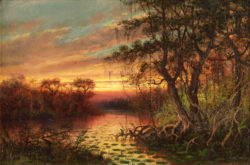Harold Rudolph
After announcing painter Harold Rudolph's arrival in New Orleans in 1873, local papers praised his portraits as being among the best ever produced in the city.

Courtesy of Roger H. Ogden Collection
Swamp Sunset. Rudolph, Harold (artist)
Though few biographical facts are known about Harold Rudolph, both the New Orleans Republican and Daily Picayune newspapers soon followed his 1873 arrival in the city with praise of his portraits as being among the best ever produced in New Orleans. Pre-eminent art dealer W.E. Seebold offered Rudolph and other artists free studio space and exhibition opportunities at his home gallery, first at 166 Canal Street (now 912 Canal Street) and then 2504 Prytania Street, both palatial abodes with regular salons hosting luminaries such as Mark Twain and George Washington Cable. Following the 1877 suicide of Brutus Ducomman, his brother-in-law and portrait partner, Rudolph changed his focus to landscapes, capturing in lush oil paints and brushstrokes the Louisiana countryside, such as evidenced in Dawn in the Bayou with Black Figures and At Sunset: Indians on the Hill.
